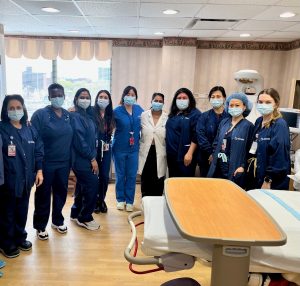 Flushing Hospital Medical Center is the proud recipient of the New York State Obstetric Hemorrhage Project 2021 Quality Improvement Award.
Flushing Hospital Medical Center is the proud recipient of the New York State Obstetric Hemorrhage Project 2021 Quality Improvement Award.
The award recognizes Flushing Hospital’s participation and dedicated work in the New York State Obstetric Hemorrhage Project which was created by the New York State Perinatal Quality Collaborative (NYSPQC) to reduce maternal morbidity and mortality associated with obstetric hemorrhage.
Maternal morbidity is defined by the U.S. Department of Health and Human Services as, “any short- or long-term health problems that result from being pregnant and giving birth.” While maternal mortality, “refers to the death of a woman from complications of pregnancy or childbirth that occur during the pregnancy or within 6 weeks after the pregnancy ends.”
Both issues have been causes for concern nationally as data shows that maternal morbidity and mortality rates in the U.S. have been inclining steadily.
In November of 2017, the NYSPQC initiated the NYS Obstetric Hemorrhage Project in collaboration with the American College of Obstetricians and Gynecologists, the Healthcare Association of New York State, and the Greater New York Hospital Association with the support of the National Institute for Children’s Health Quality to address this problem.
Flushing Hospital joined the project as part of its ongoing efforts to provide patients and their families with the best, safest, and most equitable care.
As a participant, Flushing Hospital has met or exceeded the project’s goal of assessing at least 85% of patients for risk of obstetric hemorrhage upon admission and during the postpartum period. The hospital also implemented measures to improve readiness to respond to obstetric hemorrhage.
“This project involved a multidisciplinary approach with monthly webinars and in-person meetings in Albany. Together, we worked on updating our policies, acquired a hemorrhage cart, and updated our hemorrhage kit. We also performed simulation drills and devised a hemorrhage assessment for patients antepartum, upon admission to Labor and Delivery, and postpartum. Our team has been educated and trained on all changes to ensure the delivery of quality care,” explained Maria Smilios, Director of Nursing Maternal and Child Services at Flushing Hospital.
Flushing Hospital was commended for its dedication and “exemplary work” by the New York State Perinatal Quality Collaborative. The hospital will continue to focus on improving maternal morbidity and maternal rates in its community to ensure a healthier future for all.
All content of this newsletter is intended for general information purposes only and is not intended or implied to be a substitute for professional medical advice, diagnosis or treatment. Please consult a medical professional before adopting any of the suggestions on this page. You must never disregard professional medical advice or delay seeking medical treatment based upon any content of this newsletter. PROMPTLY CONSULT YOUR PHYSICIAN OR CALL 911 IF YOU BELIEVE YOU HAVE A MEDICAL EMERGENCY.




